Variations: Brioche au Sucre: Two Brioche Loaves
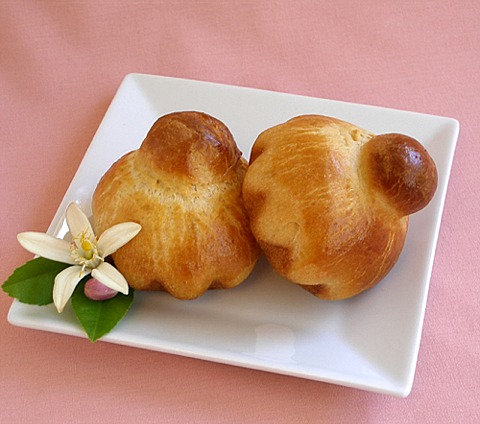
Brioche is an elegant yeast dough, a cross between bread and pastry. It is rich with butter and eggs and just a little sweet. In France, Brioche is baked in several forms, the Parisienne, or tete, such as this recipe, and the Nanterre, or Basic and Easy Brioche Loaf. The classic top-knotted shape, Brioche à tête is the most popular presentation. They rise in fluted tins, with a large ball of dough placed on the bottom, topped with a ball of dough 1/3 that weight to form the head (tête). The soft, golden loaves are sliced for breakfast or made into rich French toast, or even toasted and served as a dessert with Banana Schmutz and Creme Chantilly.
In this version, the brioche is made with an easy-to-make sponge starter, which I find gives the bread deep flavor and better texture. (Others, such as the Brioche a Tete from Panettone Dough, can be made with a Wild Yeast Sourdough Starter.) You'll notice that the sponge instructions call for adding the dry yeast without a presoak in warm water to dissolve it. This is an unusual technique, one more commonly associated with the use of fresh yeast, but it works well here. I like to use more egg yolks instead of whole eggs in the recipe for a richer taste and deeper color, so note my recipe variation, below.
BREAD RECIPE HELP
SPONGE STARTER
INGREDIENTS
1/3 cup warm whole or 2% milk (100 to 110 degrees F)
2 1/2 teaspoons (1 package) active dry yeast
1 large egg
2 cups unbleached all-purpose flour, divided; spoon into measuring cup and level to rim
BRIOCHE DOUGH
INGREDIENTS
1/3 cup sugar
1 teaspoon salt
2 large eggs and 4 large egg yolks, slightly beaten; or 4 large eggs (if using 4 large eggs, increase the butter to 3/4 cup or 1-1/2 sticks)
1 1/4 to 1 1/2 cups unbleached all-purpose flour, divided or more, if needed; spoon into measuring cup and level to rim
10 tablespoons (1 1/4 sticks) unsalted butter, smashed with a rolling pin, see NOTE, below
1 large egg, beaten, for egg wash
pearl sugar or crushed sugar, optional
NOTE: In order to incorporate the butter into the dough, during STEP II: MAKE THE BRIOCHE DOUGH, #6, you must work the butter until it has a similar consistency as the dough.
Smash the butter with a rolling pin or work it with a dough scraper until it is soft and pliable. When it's ready, the butter will be soft, smooth, and still cool, not warm, oily or greasy.
Refrigerate after preparing and before using in the recipe, if necessary. Let warm slightly to room temperature.
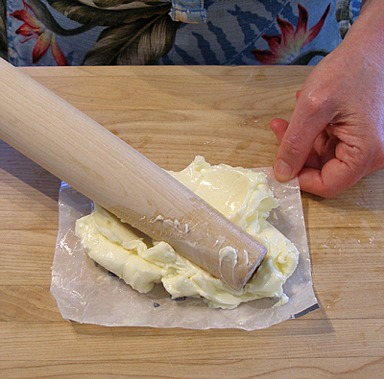
INSTRUCTIONS
STEP I: MAKE THE SPONGE STARTER
1. Rinse the mixer bowl of a stand mixer in warm water to first warm it. Pour in the warm milk.
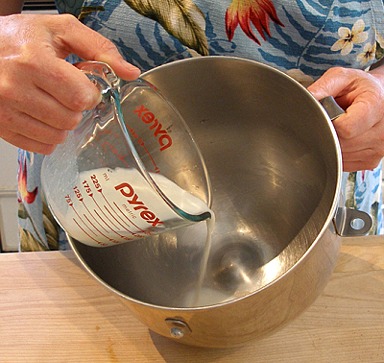
2. Sprinkle the yeast over the warm milk and let sit for a few minutes. Stir until the yeast is completely dissolved.
SARAH SAYS: Take care because yeast tends to clump when mixed with warm milk. I use a chop stick, small whisk or similar implement to stir, as a result.
If it does, squeeze the clumped yeast in between your fingertips and thumb, while holding under the milk, to dissolve.
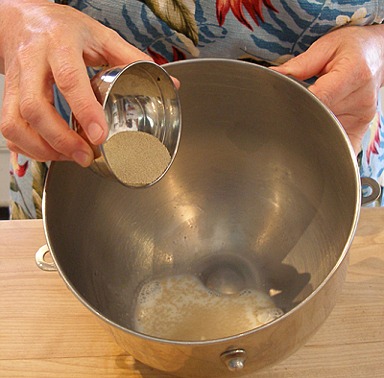
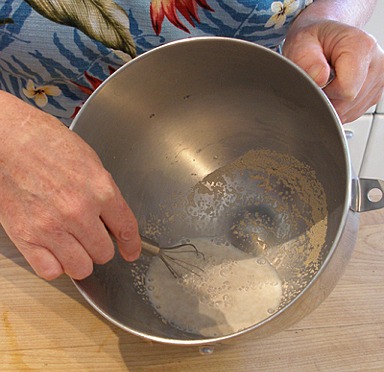
2. Add in the egg and 1 cup of the flour, and blend with a fork.
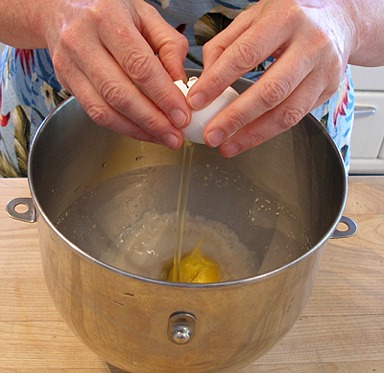
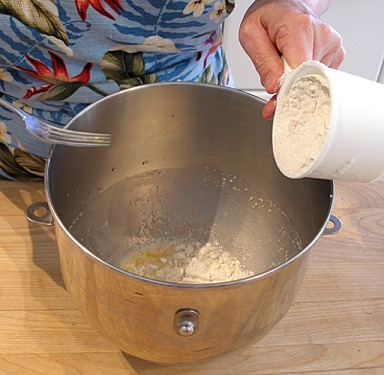
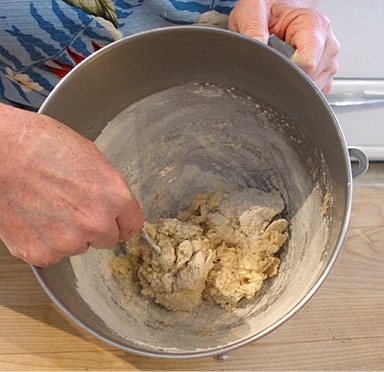
3. Sprinkle the remaining 1 cup flour over the sponge to cover. Do not stir.
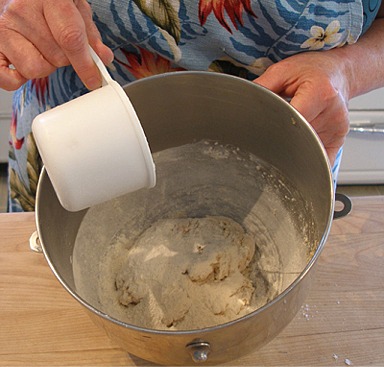
4. Set the sponge aside, tightly covered with plastic wrap, to rest 30 to 40 minutes.
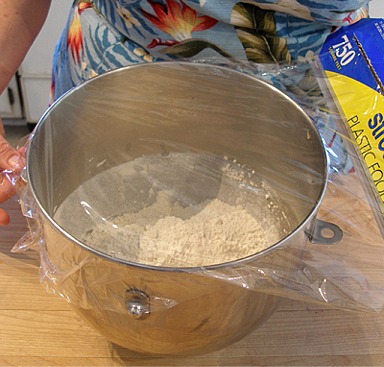
After resting, the flour on top of the sponge will look crackly.
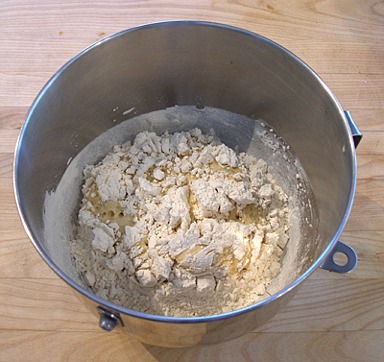
STEP II: MAKE THE BRIOCHE DOUGH
Mix the dough:
1. Fit a stand mixer with a dough hook attachment.
2. To the sponge starter in the mixer bowl, add the sugar, salt, beaten eggs and egg yolks, 3/4 cup of flour from the Brioche dough recipe to it.
Mix on low speed for a minute or two, just until the ingredients are about to come together.

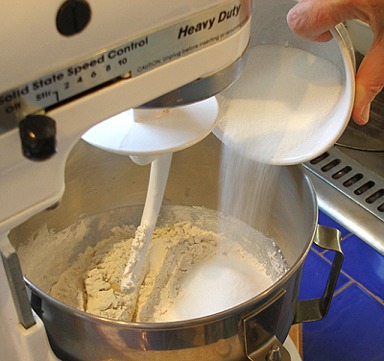
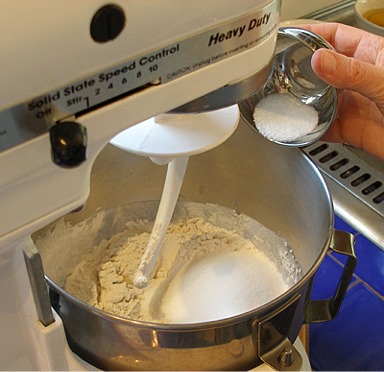
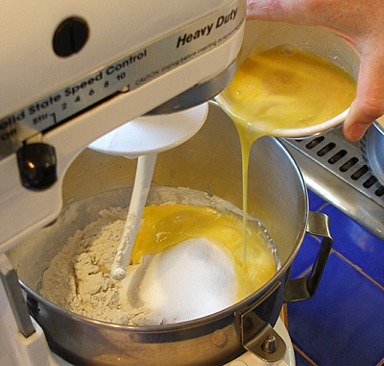
3. Still mixing on low, add in the remaining 3/4 cup flour, slowly at the side of the bowl.
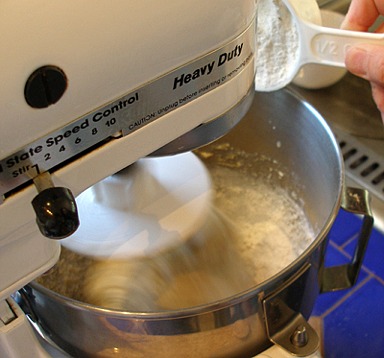
4. When the flour is incorporated, increase the mixer speed to medium and beat for about 15 minutes, stopping to scrape down the hook and bowl as needed.
During this mixing period, the dough should come together, wrap itself around the hook, and slap the sides of the bowl.
If, after 7 to 10 minutes, you don't have a cohesive, slapping dough, lower the mixing speed to low, and slowly add up to 1/4 cup more flour, slowly at the side of the bowl until the
dough does.
5. Continue to beat for the remaining time, giving the dough a full 15 minutes in the mixer — don't skimp on time; this is what will give the brioche its distinctive texture.
6. With the mixer on medium-low, add the smashed butter a few tablespoons at a time.
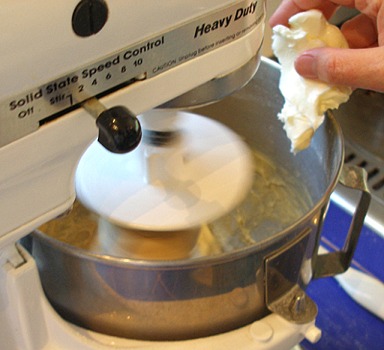
When all of the butter has been added, raise the mixer speed to medium-high for a minute, then reduce the speed to medium and beat the dough until you once again hear the dough slapping against the sides of the bowl, about 5 minutes.
SARAH SAYS: Clean the sides of the bowl frequently as you work. If it looks as though the dough is not coming together after 2 to 3 minutes, add a few sprinkles of flour, up to 1 tablespoon at a time, and continue to beat.
7. When you are finished, the dough should still feel somewhat cool. It will be soft and still sticky and may cling slightly to the sides and bottom of the bowl.
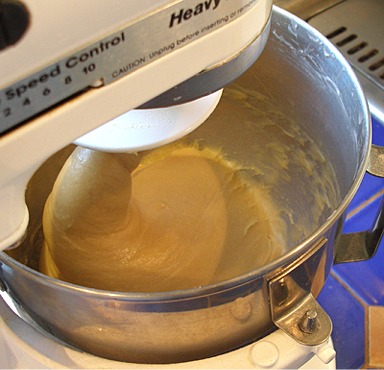
STEP III: LET THE DOUGH RISE, PREPARE THE PANS, SHAPE AND, LET RISE A SECOND TIME
First rise:
1. For the first rising, transfer the dough to a very large buttered or oiled bowl, cover tightly with plastic wrap.
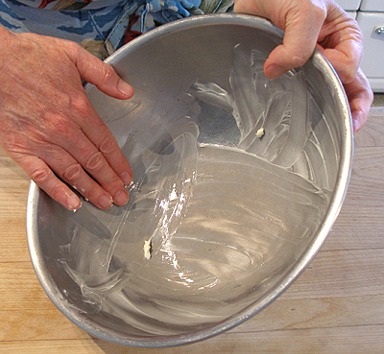
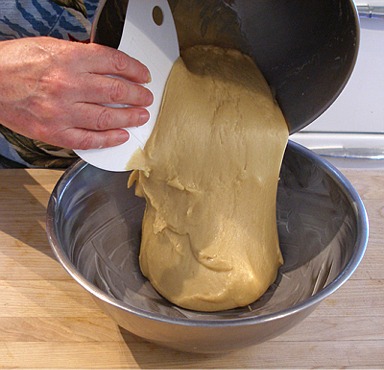
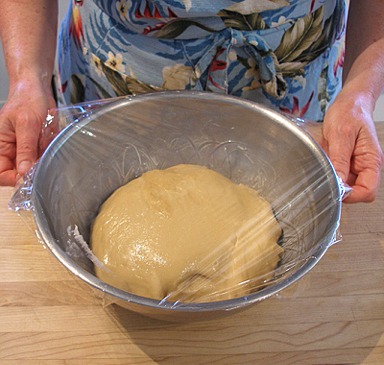
2. Let it rise at room temperature until doubled in bulk, about 2 hours.
SARAH SAYS: YIKES, Kelly! Now, that's some risen dough! LOL! You certainly DO have the magical baking TOUCH!
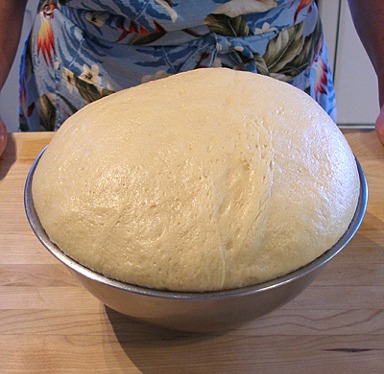
3. Meanwhile, butter two, 8-inch Brioche pans, with softened butter, using a pastry brush to make sure you get into the flutes.
Set aside in a cool place until needed.
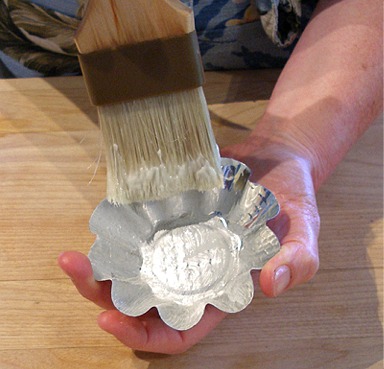
4. Deflate the dough by gently pushing it down in the bowl and folding the deflated dough over.
Shape:
SMALL BRIOCHE TETES
To make small brioche using 18, 3 1/2-inch brioche molds or standard-size muffin tins:
1. Transfer the dough to a lightly floured board.
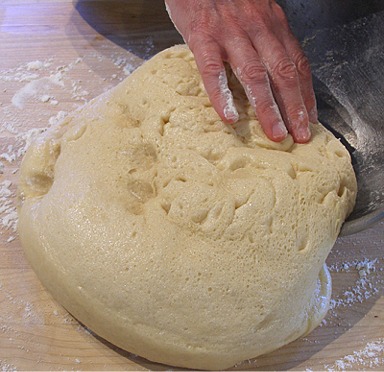
2. Divide the dough evenly into eighteen, 2-ounce size pieces.
Use a scale to help you measure them precisely.
Whatever part of the dough you are not working on, make sure you cover it loosely with greased-side-down plastic wrap so it won't dry out on its surface.
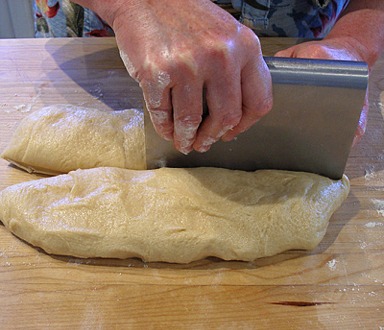
3. Cut or pinch off a piece the size of a large grape from the 2 ounce portion of dough, weighing about a 1/2 an ounce. Place on a parchment paper lined cookie sheet.
Do not smash them together; keep the pieces separate. Cover loosely with plastic wrap and place briefly in the refrigerator.
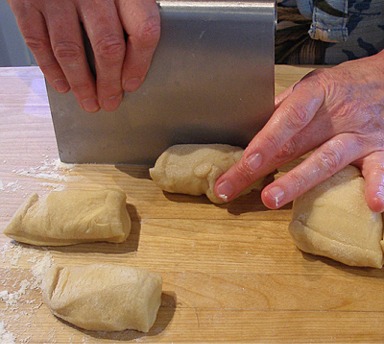
3. Roll the remaining dough into 18 golf ball-size rounds, about 1 1/2-ounces for the base of the brioche, and place one into each of prepared brioche molds or standard-size muffin tins.
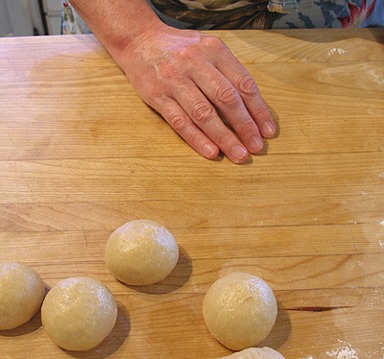
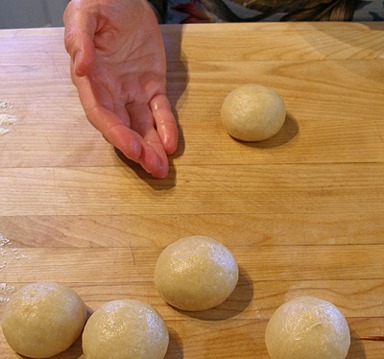
4. Make an indentation in the center of each. Remove the leftover dough from the refrigerator and shape into 18 grape-size balls. Place a “grape” in each indentation.
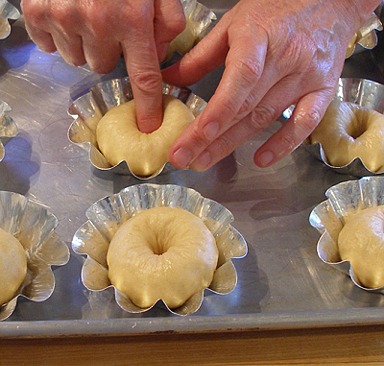
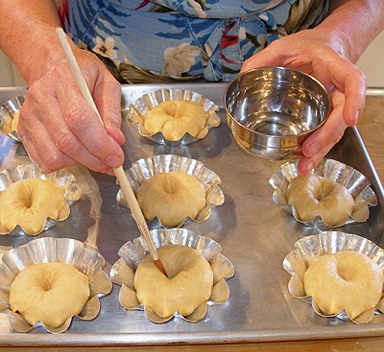
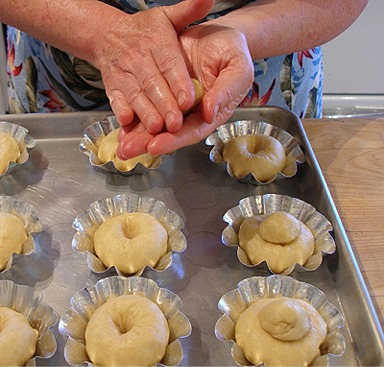
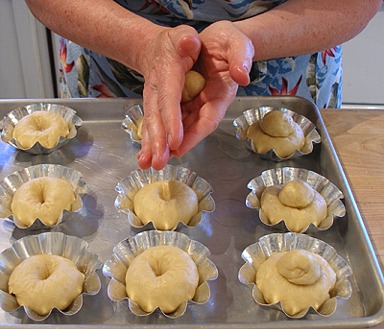
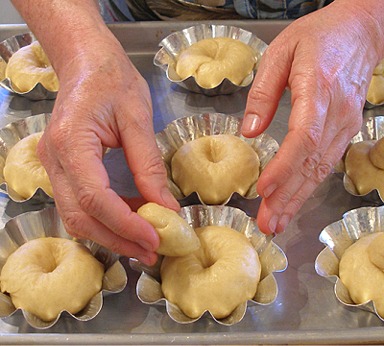
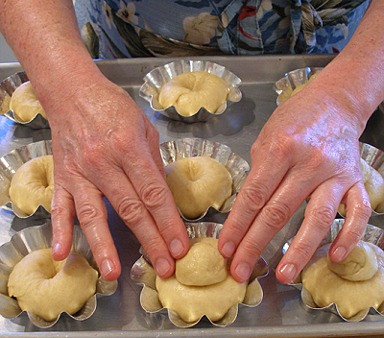
KELLY SAYS: I found that you have to make the indentation deep, or the top knot will not seat correctly, and may pop up too much.
Also, I think you forgot to mention the water thing here…you really need the water, or the ball can pop right out.
That happened on one of them that I didn't paint enough water on.
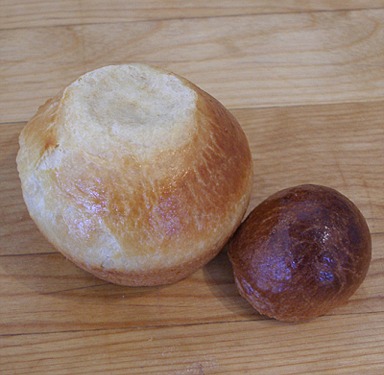
5. Cover the dough lightly with buttered plastic wrap and refrigerate. Let rise for about 4 to 6 hours or overnight.
6. Remove from the refrigerator and let stand at room temperature. Let continue to rise until each one is ALMOST doubled in bulk, about 30 minutes.
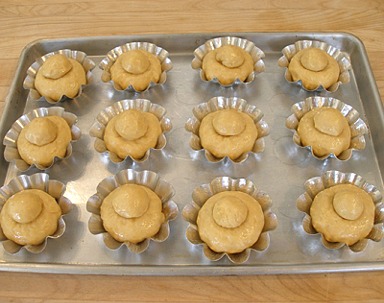
STEP IV: BAKE AND COOL
1. Meanwhile, immediately upon removing the dough from the refrigerator, position the oven shelf to the middle and preheat the oven to 375 degrees F.
2. Brush the top of the brioche with beaten egg, taking care not to let the egg dribble onto the pan, as it will impair its rise.
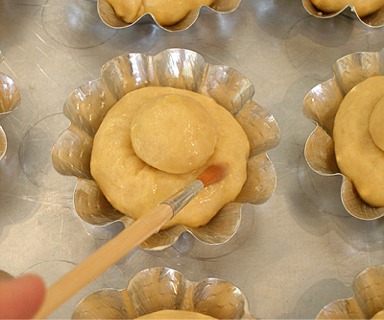
3. Bake until deeply golden brown, about 15 minutes. If the bread is browning too quickly, cover it lightly with foil.
SARAH SAYS: To test for doneness, insert a thermometer in the bottom of the bread. It should reach 200 degrees F.
It will also sound hollow when tapped on the bottom once removed from its pan.
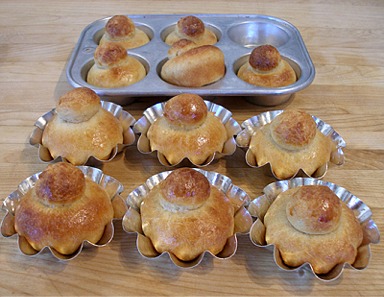
4. Let the brioches cool in their pans for about 5 – 10 minutes. Then, remove from the pans and let cool on a wire rack.
STORAGE
Brioche is best the day they are made, but can be kept nicely at room temperature for a day or two; wrap them in plastic.
Wrapped airtight, they can be frozen for a month. Thaw, still wrapped, at room temperature.

VARIATION
Brioche au Sucre: Brush with egg wash twice before baking and sprinkle pearl sugar or crushed sugar on top. When baked, the color will be a dark golden brown.
Two Large Brioche Loaves
Follow these instructions:
STEP III: LET THE DOUGH RISE, PREPARE THE PANS, SHAPE AND, LET RISE A SECOND TIME
First rise:
1. For the first rising, transfer the dough to a very large buttered or oiled bowl, cover tightly with plastic wrap.



2. Let it rise at room temperature until doubled in bulk, about 2 hours.
SARAH SAYS: YIKES, Kelly! Now, that's some risen dough! LOL! You certainly DO have the magical baking TOUCH!

3. Meanwhile, butter two, 8-inch Brioche pans, with softened butter, using a pastry brush to make sure you get into the flutes.
Set aside in a cool place until needed.
4. Deflate the dough by gently pushing it down in the bowl and folding the deflated dough over.
Shape:
1. After its first rise, transfer the dough to a lightly floured board.
2. Divide the dough in half to make two (8-inch) brioche. Keep the dough half that you are not working with covered in the refrigerator.
3. Place the dough half you are wortking with on a lightly floured work surface.
With a bench scraper, cutting straight down, cut off a scant 1/3 piece of this dough. Set aside.
4. Shape the remaining 2/3 dough piece into a ball on a VERY lightly floured surface and drop into the prepared pan.
SARAH SAYS: To form a ball, work the piece gently and quickly between your hands and against the work surface to form a smooth ball.
5. VERY lightly flour the work surface.
Roll the smaller piece of dough that has been set aside, into a pear shape. Use your fingers to make an indentation in the center of the dough that is in the brioche pan,
and fit the narrow end of the ball into the depression.
Gently pinch and press the dough together as needed to make certain the two pieces are sealed.
6. Cover the shaped dough lightly with buttered plastic wrap or an inverted bowl and refrigerate.
7. Repeat steps 1 – 6 with the remaining dough in the refrigerator.
8. Let both shaped brioche doughs rise for the second time, 4 to 6 hours or overnight.
9. Remove both from the refrigerator and let stand at room temperature. Let continue to rise until each one is ALMOST doubled in bulk, about 1 hour.
STEP IV: BAKE AND COOL THE TWO LOAVES
1. Meanwhile, about 30 minutes after removing the dough from the refrigerator, position the oven shelf to the middle and preheat the oven to 375 degrees F.
2. Brush the top of the brioche with beaten egg, taking care not to let the egg dribble onto the pan, as it will impair its rise.
SARAH SAYS: Brioche au Sucre – Brush with egg wash once more and sprinkle pearl sugar or crushed sugar on top. When baked, the color will be a dark golden brown.
3. Working quickly, use the ends of a pair of scissors to snip 2 or 3 slits in each larger ball of dough.
4. Bake until deeply golden brown, about 30 minutes. If the bread is browning too quickly, cover it lightly with foil.
SARAH SAYS: To test for doneness, insert a thermometer in the bottom of the bread. It should reach 200 degrees F.
It will also sound hollow when tapped on the bottom once removed from pan.
5. Let the brioches cool in their pans for about 5 – 10 minutes. Then, remove from the pans and let cool on a wire rack.


